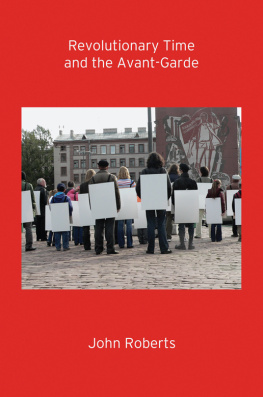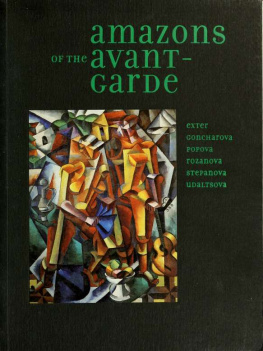REVOLUTIONARY
TIME AND THE
AVANT-GARDE
John Roberts

First published by Verso 2015
John Roberts 2015
All rights reserved
The moral rights of the author have been asserted
1 3 5 7 9 10 8 6 4 2
Verso
UK: 6 Meard Street, London W1F 0EG
US: 20 Jay Street, Suite 1010, Brooklyn, NY 11201
www.versobooks.com
Verso is the imprint of New Left Books
ISBN-13: 978-1-78168-913-4 (PB)
ISBN-13: 978-1-78168-912-7 (HC)
eISBN-13: 978-1-78168-914-1 (US)
eISBN-13: 978-1-78168-915-8 (UK)
British Library Cataloguing in Publication Data
A catalogue record for this book is available from the British Library
Library of Congress Cataloging-in-Publication Data
Roberts, John, 1955
Revolutionary time and the avant-garde / John Roberts.
pages cm
ISBN 978-1-78168-913-4 (hardcover) ISBN 978-1-78168-913-4 (paperback) ISBN 978-1-78168-914-1 (ebook, US) ISBN 978-1-78168-915-8 (ebook, UK)
1. Avant-garde (Aesthetics) 2. ArtPhilosophy. I. Title.
BH301.A94R63 2015
701dc23
2015013225
Typeset in Minion Pro by MJ & N Gavan, Truro, Cornwall
Printed in the US by Maple Press
To my daughter, Gilda
Contents
The arguments in this book have been in gestation since the early part of the millennium, when I began rethinking the function and role of the avant-garde. As such, my writing has unfolded in response to two key issues: the increasing economic crisis and shifts in the new digital economy and the labourcapital relation and the expanded post-conceptual terrain of artistic practice. Importantly, these issues overlap, redefining the functions and place of art, and, as such, transforming how we think of the relationship between artistic labour (would-be free labour) and non-artistic labour on a global basis. Indeed, the international landscape of arts production and reception is largely unrecognizable from twenty-five years ago. In this respect a great deal of art criticism and art history is now patently inadequate to the transformed horizons and thinking of contemporary art and culture. In fact what is at stake, more broadly, is a complete re-periodization of art in the twentieth century in order to shift its reified narratives and categories and their dreary intimacy with the scholarship of museum and market alike. A lot of stripping out and structural readjustment will need to be done, rather than glamorous fine-tuning or picaresque redecorating. Consequently, there is a fundamental political and philosophical requirement to forge a new language of critical engagement with the new relations of production and reception, to continue to define another place for art, a transformative place, an unmarked place, that brings the futures past of art into new constellations of meaning and new lines of engagement. This is an active and partisan requirement, then, in the face of an increasing authoritarian de-historicization of art and continuing mourning for some lost (modernist) object, or obversely, the fantasy of social connection, or promise of the promise, and all the other revived transcendental machinery of flight or denial. Thus what is required is neither a new romantic spontaneity of the non-concept to get us through theory ( la Deleuze or Latour), nor the redemption of the quotidian or picturesque in order to make us feel nostalgic about Labourism, as in T. J. Clark and Anne Wagners revivification of L. S. Lowry (Tate 2013). That the politics of art in the latter are reduced to a phantasm of a phantasm has real political implications here: it locks the spectator into a supine, this is all-we-can-hope-for from art and political transformation. English parochialism meets disappointed cultural and political expectations is a familiar story on these shores, reeling in former leftists to do the work of reason and reasonableness once the prospect of radical change has receded, but here there is a needling, disgruntled anti-avant-gardism, as if to speak of the avant-garde is to invoke the hideous spectre of infantilism. What is the greater infantilism, though to take the sleep of capitalist temporality for reality, or to wish to be wakeful at all costs? What is required on the radical left is an unabashed commitment to theoretical creativity and ambition and lack of political fear; the construction of research programmes rather than melancholic gazes and beatific (national-popular) swooning.
Some of the terms and concepts I have formulated in order to map and analyse the changes of contemporary art and a defence of the avant-garde may be familiar (post-art, deflationary critique, post-conceptualization, asociality) but most will not (autonomy-as-the-critique-of-autonomy, art after art in the expanded field, the suspensive avant-garde, adisciplinary research, situatedness, post-visualization, metastasis, the centrifugal spectator, realized reflexivity, the second economy, internationalization of the margins). Nevertheless, in both instances, the intention is not just to provide a novel array of concepts, but, rather, to give shape and coherence to the new forces and relations in art.
A number of people and events over the years have been important in the development of my thinking on the avant-garde. I would like to thank David Cunningham for inviting me to speak at Returns of were published as Art and Praxis: Metastasis, Legibility, Situatedness in The Noologists Handbook and Other Recent Art Experiments 200812, edited by Suzana Milevska (Archive Books, Berlin, 2013) and Art, Politics and the Topological Turn in Art Beyond the Market, edited by Karen van den Berg (Sternberg Press, New York, 2013). The section The Ends of Art was first written as an (unpublished) discussion document for the show The Ends of Art, curated by Euripides Altintzoglou at Beton 7 Gallery in Athens, 526 July 2013, and the section Art and the Problem of Immaterial Labour was published in ECONOMY: Art and the Subject After Postmodernism, edited by Angela Dimitrakaki and Kirsten Lloyd (Liverpool University Press, 2015).
The Avant-Garde After
Avant-Gardism
The avant-garde is currently much maligned and misunderstood. Treated overwhelmingly as a historical category by conservatives, postmodernists and revolutionaries alike in the wake of the original avant-garde, its continuing dynamism and critical content has been either denied or foreshortened. Indeed in Europe and North America in the 1980s and 1990s down to the proto-avant-gardism of Jacques Rancire and Alain Badiou today it has suffered from caricature or enfeeblement. Too often politics steps in to save the art, or art steps in to diffuse the politics, leaving the art and politics separated.epistemological and cultural reorganization of arts modes of production and reception and the identity of the artist. The category of art was no longer embedded in delimited notions of artisanal artisticness and authorship painterly or sculptural expression but in the transmaterial and post-disciplinary realm of the thought experiment. The fundamental shift initiated by modernism, then, was less the move to painterly abstraction than the subsumption of art under the logic of arts conceptual and formal conjunction. In other words, art embraced general social technique as the necessary means by which its opening up to autonomy was to be sustained against its reduction to tradition and academic precedent.



















